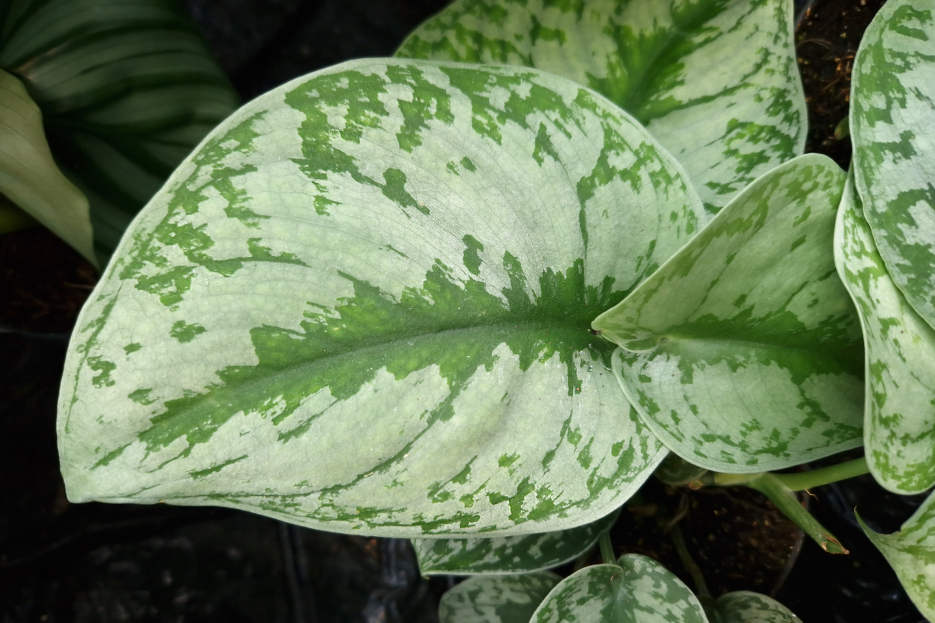
The Silver Pothos (also known as Scindapsus pictus) is a stunning, easy-to-care-for houseplant that brings a touch of elegance to any space. With its heart-shaped leaves adorned with silvery markings, this plant is a favorite among indoor gardeners. If you're looking to add this beauty to your collection, here's a comprehensive guide on how to care for Silver Pothos.
Silver Pothos thrives in bright, indirect light. While Silver Pothos can tolerate lower light conditions, it will grow more slowly, and its beautiful silvery patterns may fade. To keep your plant healthy & vibrant, place it near a window where it can receive filtered sunlight, but avoid direct sun exposure, as this can scorch the leaves. If the plant is in a darker location, you may notice that it becomes leggy, and the leaves may lose some of their color.
Silver Pothos prefers to be kept on the drier side, so it’s important not to overwater. Allow the top 1 to 2 inches of soil to dry out between waterings. Over watering can lead to root rot, so always check the soil moisture before watering. During the growing season (spring and summer), you can water the plant every 1-2 weeks, depending on how quickly the soil dries out. In the fall & winter, the plant’s growth slows down, so you may need to water less frequently.
Make sure your pot has good drainage to prevent water from accumulating at the bottom. If the plant’s leaves start turning yellow or drooping, it could be a sign of overwatering. If the leaves are dry and crispy, it may indicate underwatering.
Silver Pothos thrives in warmer temperatures between 65°F and 85°F (18°C to 29°C). Avoid placing your plant in areas with cold drafts or extreme temperature fluctuations, as this can stress the plant.
As a tropical plant, Silver Pothos enjoys moderate to high humidity. If you live in a dry climate, you can increase the humidity around your plant by placing it on a humidity tray, using a room humidifier, or occasionally misting the leaves. However, be cautious not to over mist, as this can lead to fungal issues.
Silver Pothos does well in a well-draining potting mix. A standard indoor potting soil mix works well, but you can also mix in some perlite or orchid bark to improve drainage. The key is to make sure the soil doesn’t stay too soggy, as this can lead to root rot.
When choosing a pot, ensure it has drainage holes to allow excess water to escape. Silver Pothos doesn’t like to sit in stagnant water, so proper drainage is essential for its health. Repotting is generally needed every 1-2 years, or when the plant outgrows its current pot. The best time to repot is in the spring or early summer when your plant is actively growing.
During the growing season (spring and summer), you can fertilize your Silver Pothos once a month with a balanced, water-soluble fertilizer (such as 10-10-10). This will promote healthy growth and vibrant foliage. Be sure to dilute the fertilizer to half strength to avoid overfeeding, which can cause damage to the roots - follow the directions on the bottle for application instructions.
In the fall and winter, the plant enters a dormant phase, and you can stop fertilizing. Over-fertilizing during the dormant months can harm the plant, so it's best to reduce feeding during this time.
Silver Pothos is a relatively low-maintenance plant, but regular pruning can help keep it looking neat & encourage bushier growth. If the vines become too long or leggy, trim them back to your desired length. Pruning will also help to remove any yellow or damaged leaves, improving the plant’s overall appearance.
If you want to propagate your Silver Pothos, you can easily do so by cutting a healthy vine with at least one node (the small bump on the stem where roots and leaves grow). Place the cutting in water or soil, and roots will develop within a few weeks. Once the roots are well-established, you can transplant the cutting into its own pot.
No, Silver Pothos is toxic to pets. Like other Pothos varieties, it contains calcium oxalate crystals, which can cause irritation and swelling in the mouth, throat, and digestive system if ingested.
To keep your pets safe, place your Silver Pothos in an area that is out of their reach, such as on a high shelf or in a room that your pets cannot access. If you suspect your pet has ingested any part of the plant, contact your veterinarian immediately.